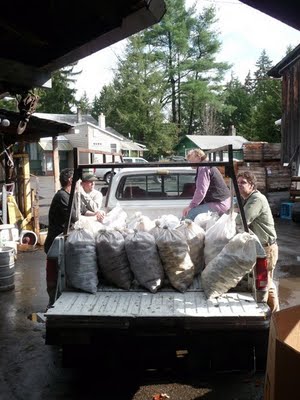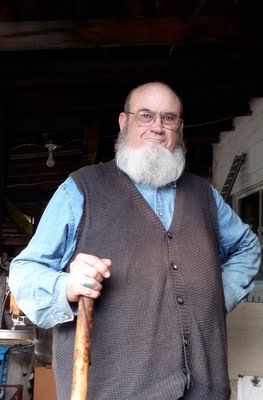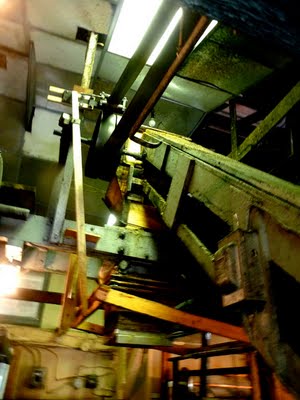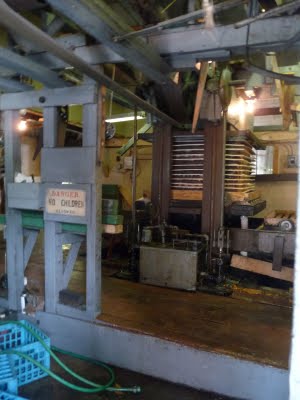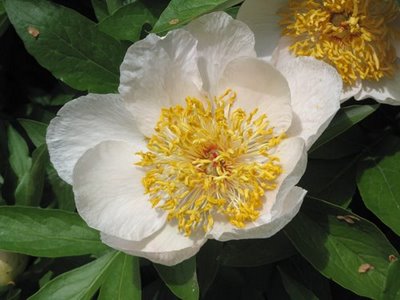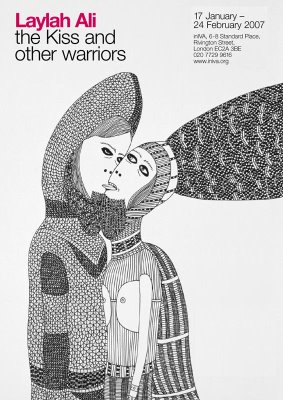 Yesterday, along with Thor Oechsner, Neal Johnston, Sandra Steingraber, and a host of others, I spoke at the Anti-Hydrofracking Day of Action in Albany. We distributed almost 200 loaves of bread to the assembled crowd, and then we marched, led by a chanting, bread-carrying farmers, to Cuomo’s office. Here is what I said:
Yesterday, along with Thor Oechsner, Neal Johnston, Sandra Steingraber, and a host of others, I spoke at the Anti-Hydrofracking Day of Action in Albany. We distributed almost 200 loaves of bread to the assembled crowd, and then we marched, led by a chanting, bread-carrying farmers, to Cuomo’s office. Here is what I said:
My name is Stefan Senders, and I am a baker. Beside me are Thor Oechsner, an organic farmer, and Neal Johnston, a miller. We work together.
Today we bring bread to Albany to intervene in the self-destruction of the great State of New York. We come, Farmers, Bakers, and Millers, to remind our state and our Governor, Andrew Cuomo, that despite the promises of industry lobbyists, the exploitation of Shale Gas in New York is bad and broken economy of the worst kind.
This bread is the product of our community and our farms. The wheat, grown, tended, and harvested by our local organic farmers, is fresh from the soil of New York. The flour, ground in our local flour mill, is as fine as concerned and caring hands can make it.
To resurrect a term long since emptied by advertisers, the wheat, the flour, and the bread are ‘wholesome’: they bring our communities together, give us work, nourish us, please our senses, and make our bodies and our land more healthy.
This is good economy. It is wise economy. It is a steady economy that nourishes the State of New York.
We know that for many New Yorkers, Fracking sounds like a good idea. We have all heard the fantastic tales: Fracking, it is said, will save our state from financial ruin, release us from our dependence on “foreign oil,” and revive our rural economy by bringing cash, if not fertility, to our once vibrant farmland.
For politicians, these stories of money and growth are hard to resist: the numbers are large, deficits are unnerving, and elections are expensive.
For many farmers and land-owners, the promises of cash are dizzying, and to risk the land’s fertility to extract gas is only one step removed from risking the land’s fertility to extract a few more bushels of corn or soybeans.
But farmers might know better.
Farming has not always been, and need not be, an extractive industry. There was a time when farmers worked with a longer view, keeping in mind their role as stewards and caretakers of the land. That long view is the farmer’s wisdom, and it is as good and wise today as it ever was.
The promises of the gas industry are demonstrably false, and they miss what farmers know well: There is no independence that does not demand care and responsibility. There is no quantity of cash that can restore fertility to a poisoned field. There is no adequate monetary “compensation” for poisoned water. There is no payment, no dollar, no loan, that can restore life and community to a broken world.
Our work and the work we provide others—on the farm, at the mill, and at the bakery—depends on fertile soil, pure water, and a viable community. All of these are put at risk by Fracking.
What happens to our land in an economy bloated by gas exploitation? Prices rise, rents rise, and good, arable land becomes scarce as acres once leased to farmers are set to quick development schemes—flimsy housing, storage barns, parking lots, and man-camps.
And what happens to our water when gas exploitation takes over? Storage pools, as safe as Titanic was unsinkable, overflow, contaminating the soil; inevitable leaks in well-casings allow gasses and Frack-fluids to pass into our aquifers, into our bodies, and into the bodies of our children.
And what happens to communities held in thrall to gas exploitation? As we have seen in other parts of the country, the boom-bust cycle of the petroleum economy fractures communities, undermining our capacity to act wisely and civilly.
With every boom, a few get rich, a few do better, but all are impoverished. For every hastily built motel there are dozens of apartments with rising rents; for every newly minted millionaire there are many dozens who see nothing but the pain of rising costs and receding resources. For every short-term dollar there are hundreds in long-term losses that can never be recouped.
To go for gas is to go for broke.
With this bread we are here to remind you that there is another economy, one that works.
This bread symbolizes a commitment to the health of New York State. It embodies the knowledge that good work, not a gambler’s dream, is the basis of a sound and sustainable economy.
This bread symbolizes the farmer’s simple truth that without fertile soil, without pure water, and without strong community, we go hungry.
This bread reminds us all that the promises of gas exploitation are empty: What are we to grow in fields broken by the drill and tilled with poison? What are we to feed our children when our water and wheat are unfit? Shall we grind money to make our bread?
We do have a choice. We need not poison our land to live. We need not taint our water to drink. We need not sell our future to finance our present. These are choices, not inevitabilities.
With this bread we say: take the long view; pay attention to the health of the soil and nourish it; treasure pure water; remember the value of your community and keep it whole.
If something must be broken, let it not be shale. Let it be this bread.
Advent 2015: Day Eight
Three French Hens #3
Q. Cassetti 2015




